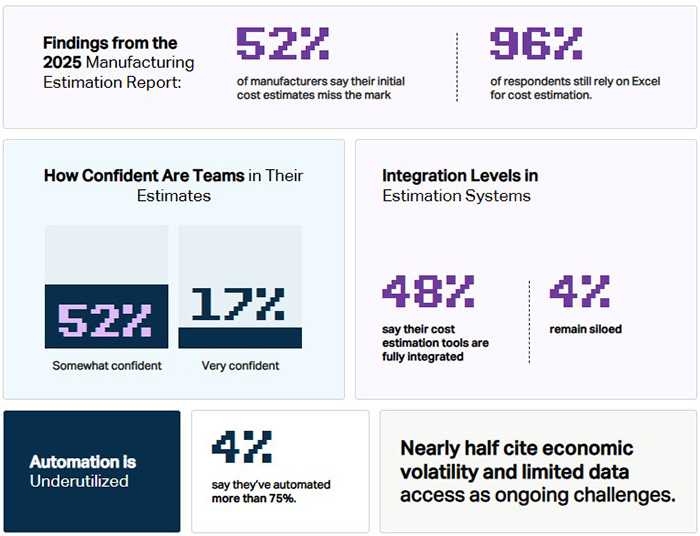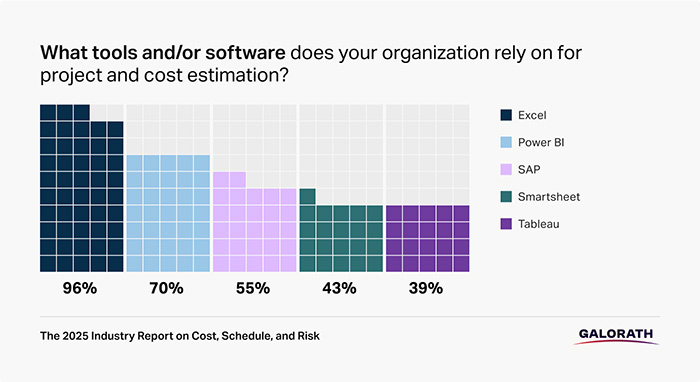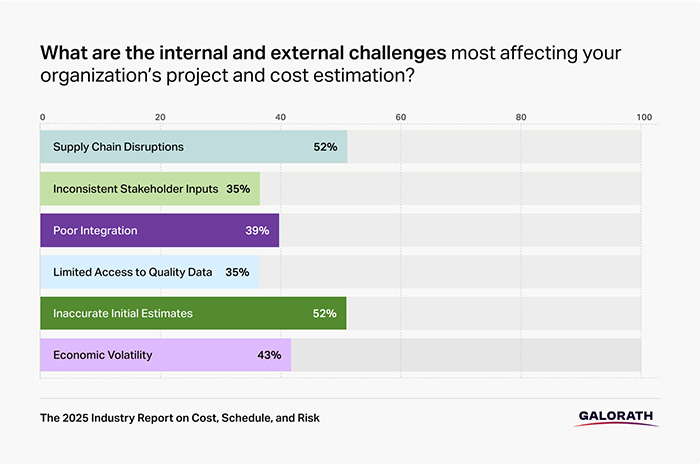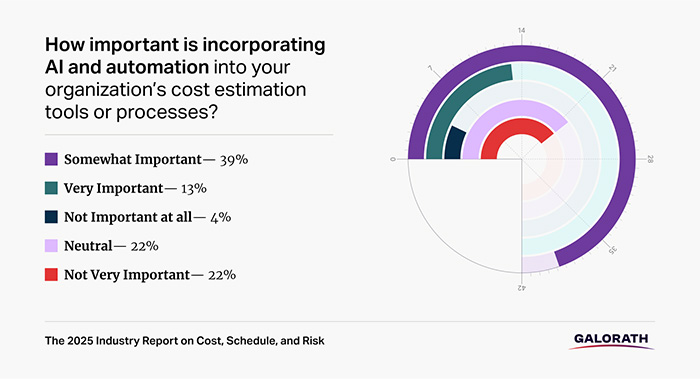Industry report reveals key barriers and frustrations in cost estimation; simple solutions can help companies begin to modernize.

By Charles Orlando, Chief Strategy Officer, Galorath Incorporated
As we enter the second half of 2025, manufacturing is already outpacing traditional working methods in today’s fast-moving landscape. Teams are being pushed to their limits while managing rising customer expectations with unstable material costs, tariff unknowns, and accelerated supply chain disruptions. Cost estimation is one of the most critical – and often overlooked – drivers of manufacturing performance. However, although it directly impacts delivery timelines, profit margins, and customer satisfaction, it is frequently managed through disconnected systems and outdated processes that can’t keep up with manufacturing today.
Based on the recent 2025 State of the Industry Report on Cost, Schedule, and Risk, the results are clear: outdated tools and manual workarounds are holding manufacturers back. Companies can’t rely on long-antiquated cost estimation tools, processes, methods, and tools. From front-line issues like inaccurate quotes and delayed decisions to larger issues like slow speed to market and reduced corporate profitability, the consequences of lagging behind in modernization are significant. To stay competitive, agile, and profitable, forward-thinking manufacturers are turning to integrated platforms, data-driven strategies, and artificial intelligence that enable insight, precision, and speed.

The report outlines the following five key trends in manufacturing and offers guidance on shifting to real-time data and connected systems fit for today’s volatility.
1. Traditional Estimation Is Falling Short
More than half of manufacturers say their initial cost estimates miss the mark, with the majority of projects kicking off with faulty assumptions. This is not because teams aren’t trying or don’t have the skills; the problem lies in outdated tools, old, siloed insights, and limited access to real-time data.
Moreover, these inaccurate estimates set off a chain reaction. When costs go up or timelines shift midway through a project, teams are forced to scramble, reworking budgets, renegotiating with suppliers, and reshuffling schedules. When organizations leverage better systems, tools, and accurate, historically-informed data from the start, these challenges can be avoided or eliminated.
2. Spreadsheets Remain the Go-To
According to the report, 96% of manufacturers still lean on Excel to manage estimation workflows. While run-of-the-mill spreadsheet software can be a convenient option, these legacy applications are from an era where speed, collaboration, and integration with other platforms and processes were not critical for competitive advantage.
As of May 2025, a mere 4% of manufacturers have automated more than three-fourths of their estimation process. Meanwhile, 65% have only partially automated between one quarter and one half of their workflows. This means most teams are still forced to use mostly-manual processes, reducing speed and effectiveness while raising the risk of business-critical errors. Reducing the use of old software and instead leveraging platforms and collaborative processes built specifically for manufacturing estimation can offer faster, more accurate calculations, version control, collaboration features, and system integrations.

3. Lack of Confidence Is Holding Teams Back
Only 17% of respondents say they are “very confident” in the accuracy of their estimates. This lack of conviction isn’t about the people; it’s a reflection of old systems and processes. When teams don’t fully trust the numbers and analysis from the systems in place they hesitate, causing slowdowns procurement and approvals, making cross-team collaboration and trust more difficult.
It is extremely difficult to forecast accurately or back up assumptions when the data and methodology aren’t dependable. Building team confidence requires, access to collaborative tools and platforms, real-time feedback loops, and leadership support.

4. Rising External Pressures Are Changing the Game
Internal demands combined with external pressures can make accurate estimation more challenging. In the report, more than half of all respondents said their biggest hurdles include supply chain disruptions and inaccurate initial estimates, with 43% citing economic volatility, 39% flagging poor integration with project management tools, and 35% highlighting limited access to quality data.
When companies have the right systems in place and teams operating as a unified ecosystem, they’re better equipped to handle the unexpected and minimize the impact of external pressures.

5. Slow Adoption of Artificial Intelligence
While over half of manufacturers say incorporating AI and automation is “very or somewhat important” to their estimation process, most organizations have not begun the process of integrating AI into their processes and workflows.
Common concerns from the report include the perception of lack of transparency in AI platform responses, implementation effort, and return on investment uncertainty. As of May 2025, AI already has the capability to dramatically improve everyday challenges with speed, insight, and knowledge access. By starting small and focusing on one clear use case, teams can adopt it more easily and comfortably.

To ensure competitive advantage, manufacturers must focus on modernizing their cost estimation platforms, platforms, and workflows. Better tools and processes ensure teams spend less time correcting mistakes and more time collaborating on growth strategy. In a fast-paced market, that kind of nimbleness makes the difference between market leader and struggling follower.
Assessing and shifting your cost estimation processes: a three-point plan of action
Manufacturers know what will dramatically improve their organizations’ processes: 87% are looking to automate repetitive tasks, nearly 80 % are seeking real-time data integration, three-fourths want better reporting and visualization tools, and nearly halfare looking for ways to benchmark against past projects more effectively.
The challenge? Expectations are rising faster than most teams can keep up, and many team members are still hesitant to embrace new tools. Those manufacturers that invest in smarter systems, stronger data, and internal know-how will be in a solid position to lead by example. The ones that don’t risk falling further behind.
About the Author:
Charles Orlando leads strategy, AI innovation, and go-to-market at Galorath. He drives the company’s AI initiatives, including SEERai—the award-winning, AI-powered enterprise platform for cost, schedule, and risk estimation. With 30 years in B2B SaaS and applied AI, he focuses on secure, real-time platforms for enterprise operational intelligence and high-impact execution across complex, high-stakes environments. He holds degrees from UC Berkeley and Arizona State University, where his award-winning thesis explored the impact of artificial intelligence on human language learning and teaching processes in higher education environments.
Read more from the author:
Generative AI for Manufacturing 4.0 | Today’s Medical Developments, February 2025
Harnessing AI and ML to Navigate Market Volatility | Supply & Demand Chain Executive, May 2025
In this episode, I sat down with Beejan Giga, Director | Partner and Caleb Emerson, Senior Results Manager at Carpedia International. We discussed the insights behind their recent Industry Today article, “Thinking Three Moves Ahead” and together we explored how manufacturers can plan more strategically, align with their suppliers, and build the operational discipline needed to support intentional, sustainable growth. It was a conversation packed with practical perspectives on navigating a fast-changing industry landscape.